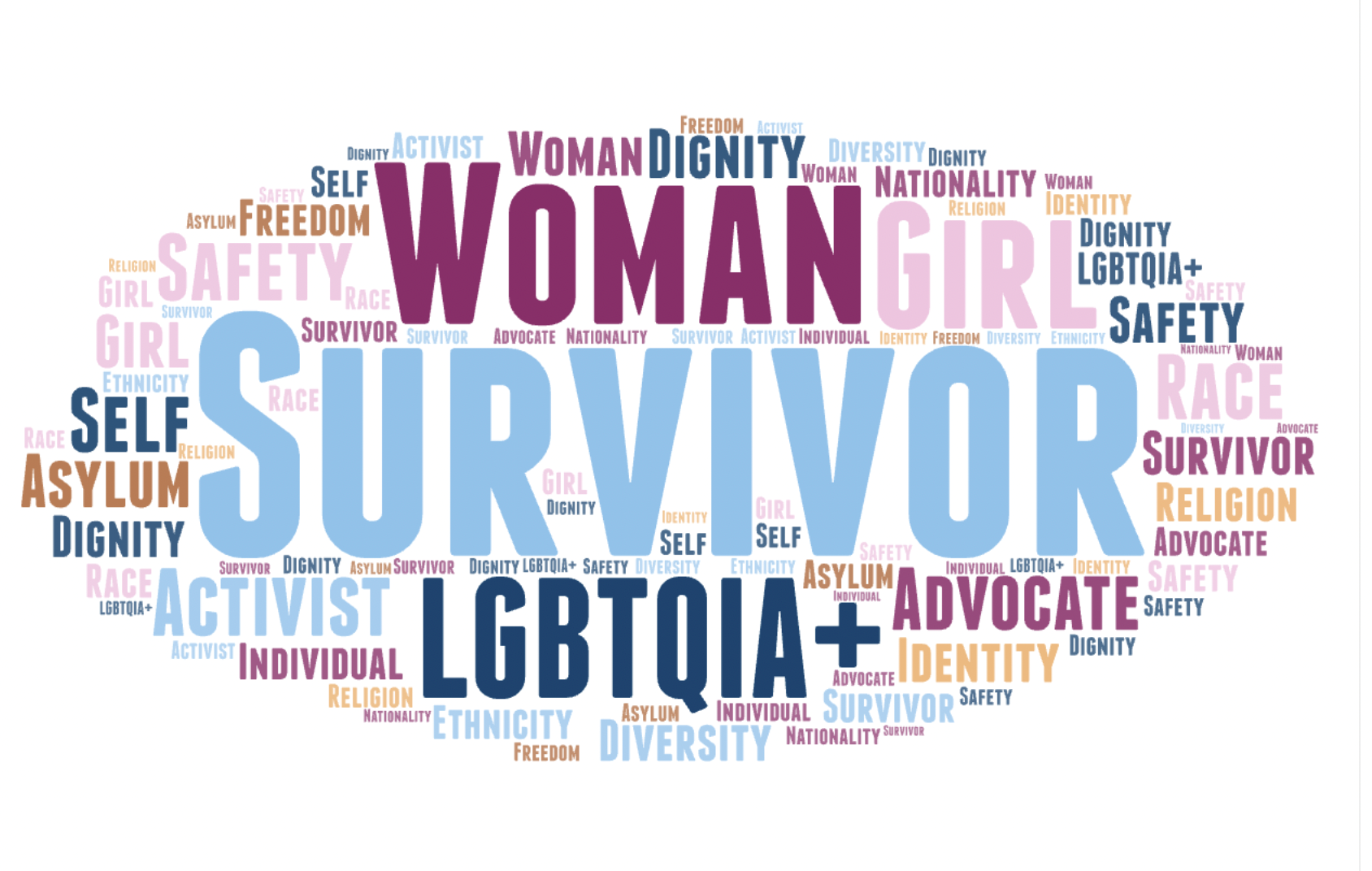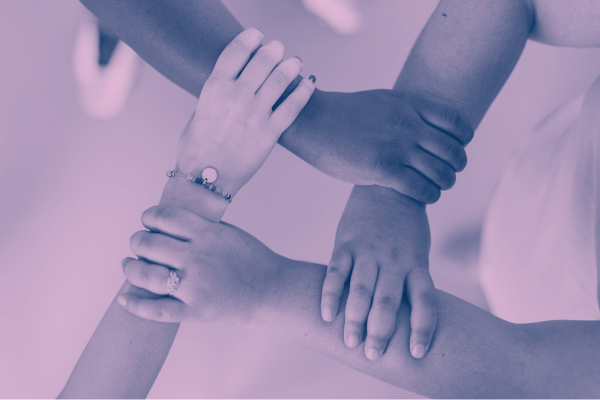Tahirih’s interdisciplinary approach to direct services, policy advocacy, and training and education is underscored by the intersection of our clients’ diverse lived experiences. Every individual we serve has multiple overlapping identities that lead them on a unique path to seeking safety from persecution.
Introduced in 1989 by American civil rights advocate and law professor Kimberlè Crenshaw, intersectionality emphasizes the idea that identities should not be regarded separately of one another. Social identities should be considered as interconnected relationships that both enhance an individual’s lived experiences and complicate their encounters with systems of oppression.
“[Intersectionality is] basically a lens, a prism, for seeing the way in which various forms of inequality often operate together and exacerbate each other. We tend to talk about race inequality as separate from inequality based on gender, class, sexuality, or immigrant status. What’s often missing is how some people are subject to all of these, and the experience is not just the sum of its parts.” – Kimberlè Crenshaw
When we think of the words “immigrant survivor,” we imagine strength and resilience across diverse identities — race, ethnicity, sexual orientation, economic status, gender identity, immigrant status, and more.

Intersectionality Past and Present
Introduced in Crenshaw’s 1989 paper “Demarginalizing the Intersection of Race and Sex: A Black Feminist Critique of Antidiscrimination Doctrine, Feminist Theory and Antiracist Politics,” the term “intersectionality” describes how violence against Black women is influenced by social identities, such as race and class.
In her 1991 paper “Mapping the Margins: Intersectionality, Identity Politics, and Violence Against Women of Color,” Crenshaw uses intersectionality to explain how the movement to end violence against women fails to address vulnerabilities unique to women of color.
Scholars and activists have since widened the scope of intersectionality to encompass a variety of social identities, issues, and political and legal systems.
Intersectionality can highlight the overlap of oppressive systems, such as racism, classism, ableism, sexism, and xenophobia, to investigate the root causes of gender-based violence and other forms of oppression. Today, intersectionality has become the center of dialogue across various disciplines and is applied widely in activism and social justice initiatives.
To learn more, watch the video “What is intersectionality?” below:
Intersection of race and gender-based violence
Women of color experience domestic violence and sexual violence at disproportionately high rates. Racism poses a significant obstacle for survivors of color as they navigate the legal system and survivor support services. For many survivors of color, distrust in law enforcement is a factor that prevents them from seeking assistance and reporting crimes perpetrated against them.
Racial justice plays an important role in the movement to end gender-based violence. In the context of survivor support services, racial justice must address the effects of individual and institutional racism. By adopting an intersectional racial justice approach, we can identify the practices and social constructs that allow cycles of violence against women to continue.
Intersection of gender-based violence and immigration
An individual’s immigration status can make them more vulnerable to gender-based violence. Survivors are more likely to stay in abusive situations out of distrust towards law enforcement and fear of deportation. Abusers often use an individual’s immigration status to maintain a dynamic of power and control by withholding information, refusing to petition for their immigrant spouse’s legal status, and limiting access to important documentation.
Thanks to the Violence Against Women Act, noncitizens who have been abused by a U.S. citizen or lawful resident spouse or relative may self-petition for permanent residence without the sponsorship of their abuser.
However, the VAWA Reauthorization Act of 2022 falls short for immigrant survivors.
For immigrant survivors, any number of their multiple identities overlap to create varying levels of vulnerability to discrimination and violence. Factors such as language barrier, financial dependency, and culture play a part in an individual’s experience with gender-based violence, acting as an obstacle to seeking support services.
Intersection of race and immigration
Black migrants experience disproportionate negative impacts of U.S. asylum policy and anti-Black discrimination at the southern border. For many Black migrants, especially those from Haiti and West Africa, racial identity increases the risk of gender-based violence at and around the southern border.
While awaiting asylum in the United States, Black girls and women experience high rates of harassment, physical and sexual assault, and solicitation for sex work.
Many Black migrants face barriers to accessing safe housing free of discrimination and targeted harassment. While awaiting asylum, Black migrants face additional risks due to targeted violence at the hands of cartels and harassment by Mexican police.
Migrants often face challenges accessing legal and social resources, including the CBP One App, a mobile phone application that is required to schedule arrival appointments at ports of entry along the southern border. In addition to concerns over language barriers, CBP One App’s facial recognition software fails to discern the features of many Black and brown migrants—leaving them unable to register for an appointment.
According to research in “Surviving Deterrence: How U.S. Asylum Deterrence Policies Normalize Gender-Based Violence,” a report by Oxfam and Tahirih Justice Center, “the US’s racialized, deterrence-based asylum system harms survivors of gender-based violence, and women, girls, and LGBTQIA+ individuals in particular.”
Intersection of LGBTQIA+ identity, immigration, and race
Lesbian, gay, bisexual, queer, intersex, and asexual (LGBTQIA+) individuals face a higher risk of poverty and marginalization, which leads to an increased risk of violence. Individuals in the LGBTQIA+ community experience increased risks of hate-driven violence, often in the form of sexual violence. Among the broader LGBTQIA+ community, transgender people and bisexual women experience the highest rates of sexual violence.
LGBTQIA+ migrants, particularly people of color, experience targeted violence due to their sexual orientation and gender expression. At the southern border, LGBTQIA+ migrants face compounded risks of violence due to overcrowded and insecure housing, drug cartels, and abuse at the hands of police and immigration officials.
Long wait times at the southern border cause individuals to experience economic instability and personal isolation, increasing LGBTQIA+ migrants’ vulnerability to violent crime. Transgender migrants are especially at risk of experiencing physical and sexual assault, harassment, and solicitation for sex work while they await the opportunity to claim asylum in the United States.
When detained in immigration facilities, LGBTQIA+ individuals, and especially transgender people, face targeted physical and sexual violence.
Importance to Our Work
At Tahirih, our direct legal and social services are centered on those who are most marginalized —immigrant women, girls, and all survivors seeking freedom from gender-based violence.
The multiple intersections of our work are too often underrepresented and overlooked, yet without an intersectional framework, our interdisciplinary, trauma-informed approach would not be possible.
We recognize the vast range of human identities that further complicate our clients’ encounters with systems of oppression. By identifying the diverse lived experiences, personal identities, and additional barriers to safety for immigrant survivors, we can better advocate and work to change the systems that are complicit in the conditions of their oppression.
Learn more about the incredible organizations providing resources and services at the intersections of our work:
- Black Immigrant Rights
- Intersections of Gender-Based Violence
- LGBTQIA+ Community
Resources Referenced:
Amnesty International, “United States of America: Mandatory Use of CBP One Application Violates the Right to Seek Asylum,” available at: https://www.amnesty.org/en/documents/amr51/6754/2023/en/
Devon W. Carbado, Kimberlé Williams Crenshaw, Vickie M. Mays, and Barbara Tomlinson, “Intersectionality: Mapping the Movements of a Theory,” available at: https://www.ncbi.nlm.nih.gov/pmc/articles/PMC4181947/
Human Rights Campaign, “Sexual Assault and the LGBTQ Community,” available at: https://www.hrc.org/resources/sexual-assault-and-the-lgbt-community
Ivonne Ortiz, “Why is it important to bring a racial justice framework to our efforts to end domestic violence?,” available at: https://vawnet.org/news/why-it-important-bring-racial-justice-framework-our-efforts-end-domestic-violence
Oxfam America and the Tahirih Justice Center, “Surviving Deterrence: How US Asylum Deterrence Policies Normalize Gender-based Violence,” available at: https://www.tahirih.org/news/u-s-asylum-deterrence-policies-increase-risk-of-gender-based-violence/
Patty Branco, “Awareness + Action = Social Change: Why racial justice matters in the prevention equation,” available at: https://www.dvawareness.org/node/63
Tahirih Justice Center, “Understanding the Intersections of Sexual Assault and Immigration Status,” available at: https://www.tahirih.org/news/understanding-the-intersections-of-sexual-assault-and-immigration-status/#:~:text=In%202022%2C%2057%25%20of%20Tahirih,immigrants%20may%20experience%20social%20isolation%2C
The White House, “Fact Sheet: Reauthorization of the Violence Against Women Act (VAWA),” available at https://www.whitehouse.gov/briefing-room/statements-releases/2022/03/16/fact-sheet-reauthorization-of-the-violence-against-women-act-vawa/
U.S. Citizen and Immigration Services, “Abused Spouses, Children and Parents,” available at: https://www.uscis.gov/humanitarian/abused-spouses-children-and-parents

